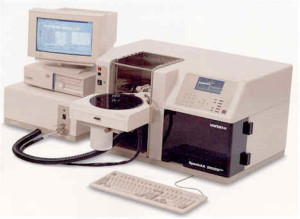Inductive Coupled Plasma and Atomic Absorption
Graphite Furnace AA (GFAA)

aa-55
This technique often allows for 1000-fold greater sensitivity than flame AA. Instead of utilizing a flame to atomize the sample, an electrical current is passed through a graphite tube which contains the analyte. The resonant wavelength of choice from the spectral lamp passes through the center of the graphite tube with the sample vapor. The atomized element absorbs the light energy over time. The area under the Time-Absorbance curve is most often the parameter of choice used to determine concentration by way of a calibration curve. Zeeman AA makes use of the absorbed spectral lines being split in the presence of a strong magnetic field. That splitting can be used to compensate for over two (2) units of background absorbance.
Zeeman GFAA uses a few microliters of sample with analyte concentrations on the order of picograms to give reliable results.
Flame Atomic Absorption
This technique allows us to quantify the amount of a specific element present in a sample. Some sample preparation may be required. Typically, this involves getting a solid sample into an acidified solution. The diluted solution is aspirated into a flame to atomize the sample. An element-specific or resonant wavelength of light passes through the atomized sample cloud. The amount of light that is absorbed by the sample is directly proportional to the concentration of the ground state element of interest in that aspirated sample. Some samples may have matrix, chemical, and/or ionization interferences. When recognized, each interference can usually be controlled to yield meaningful sample analysis.
Information
- AA is a bulk analysis technique which gives quantitative and qualitative data.
- If the sample can be dissolved into solution and atomized, nearly all elements can be determined.
- Flame AA uses milliliters of sample as opposed to Graphite which uses microliters of sample.
- Sample must dissolve in an aqueous acid.
- Sample may need ion suppression or another chemical to modify the mixture.
- Sample preparation is the key to accuracy and precision. The AA is in ppm and the graphite furnace is ppb.
Inductively Coupled Plasma-Atomic Emission Spectroscopy (ICP-AES)
Theory of Operation
An argon gas flows down three concentric quartz tubes centered in water cooled coils of an RF generator. The gas is made electrically conductive by Tesla sparks. ‘Me magnetic field of the RF coil is axially oriented in the quartz tubes thus inducing an annular flow of electric current in the argon plasma. This produces temperatures in the range of 5,000- 10,000 Kelvin as a result of ohmic heating. Proper regulation of the argon gas 6ows allows a stable annular plasma to be maintained above the ends of the concentric tubes. A liquid sample is aspirated into the center tube, and it flows into the plasma. The complete plasma torch configuration. Solvent evaporates prior to reaching the actual plasma and atomization of the elements present in the sample solution occurs in the extremely high temperature of the plasma. Thermal excitation of valence electrons to higher allowed energy states takes place. When relaxation to the ground state occurs the energy difference between the excited state and the ground state is emitted as a quantized photon. The photon wavelengths emitted are commonly visible in the ultra-violet portion of the electromagnetic spectrum (UV-VIS). By separating the various emission wavelengths with a monochromator, qualitative information is gathered. By monitoring the relative intensity at a particular wavelength and comparing this intensity to that generated by introduction of a known external standard into the plasma, quantitation is achieved. Detection limits in solution are on the order of ppb for most elements.